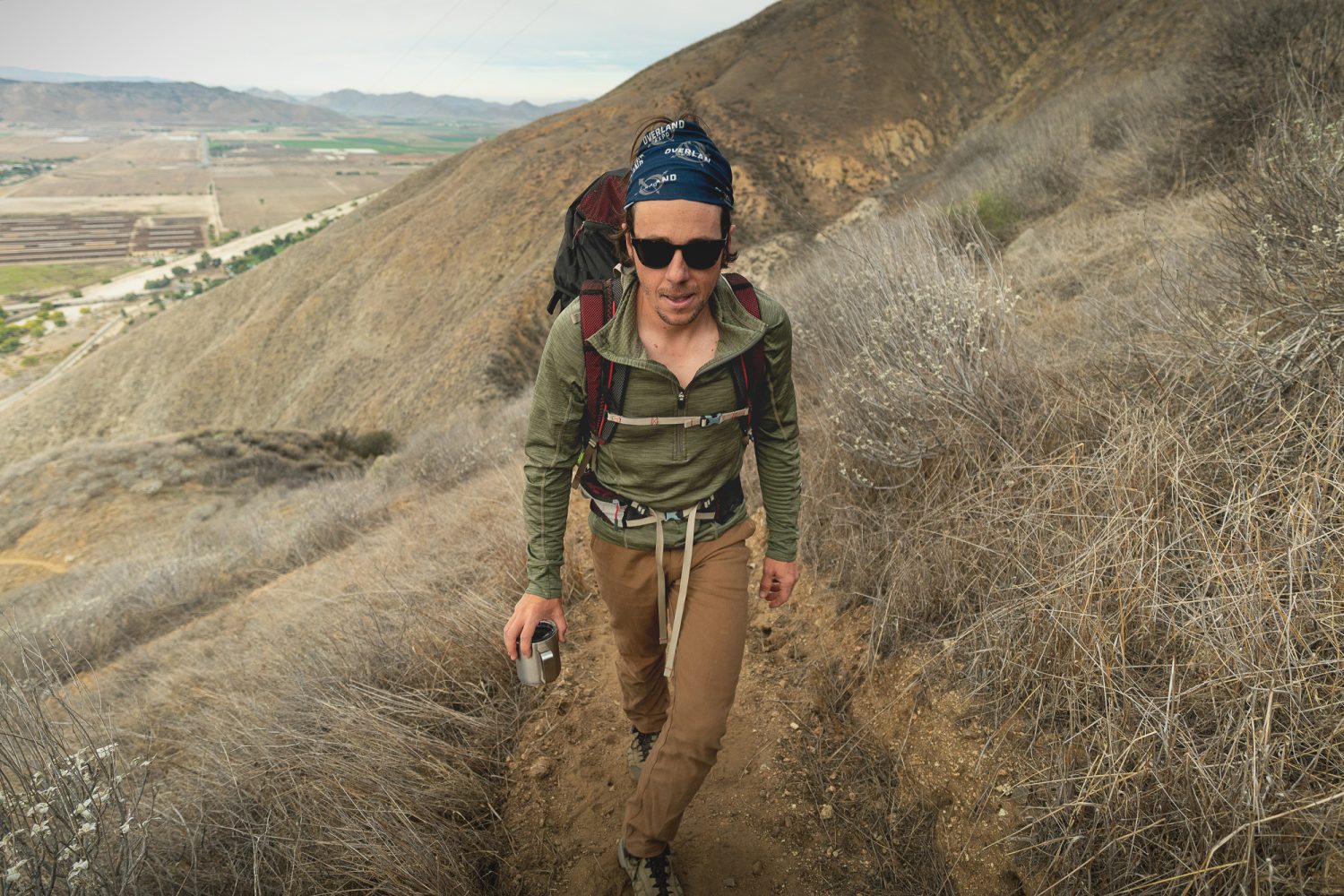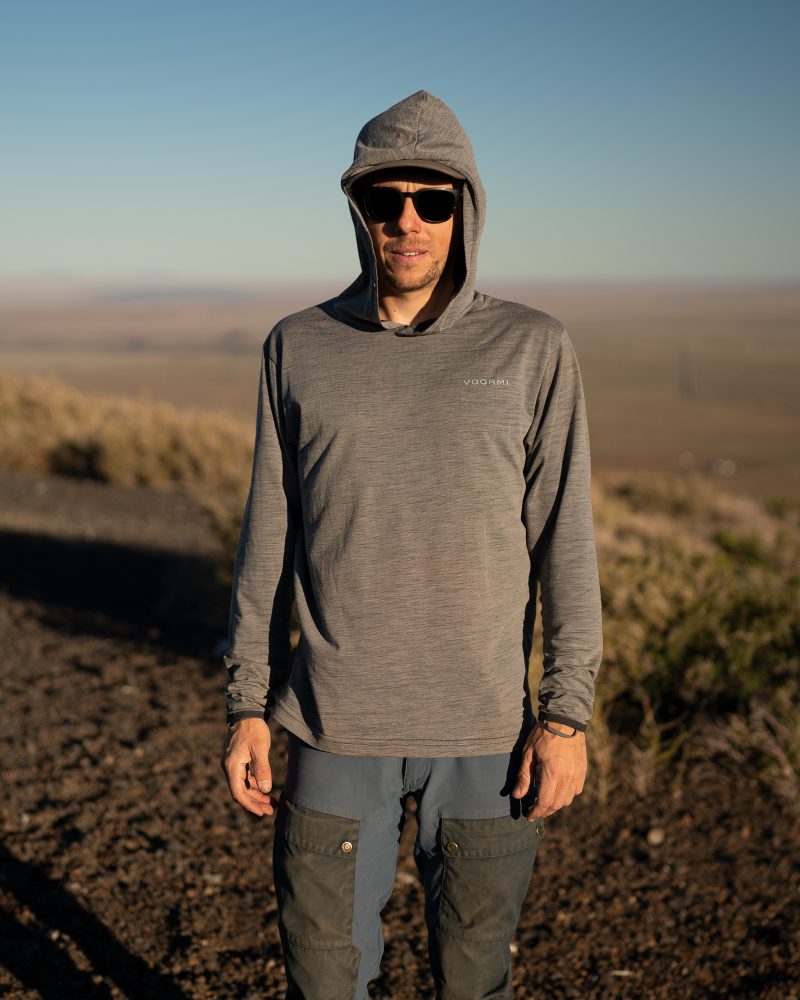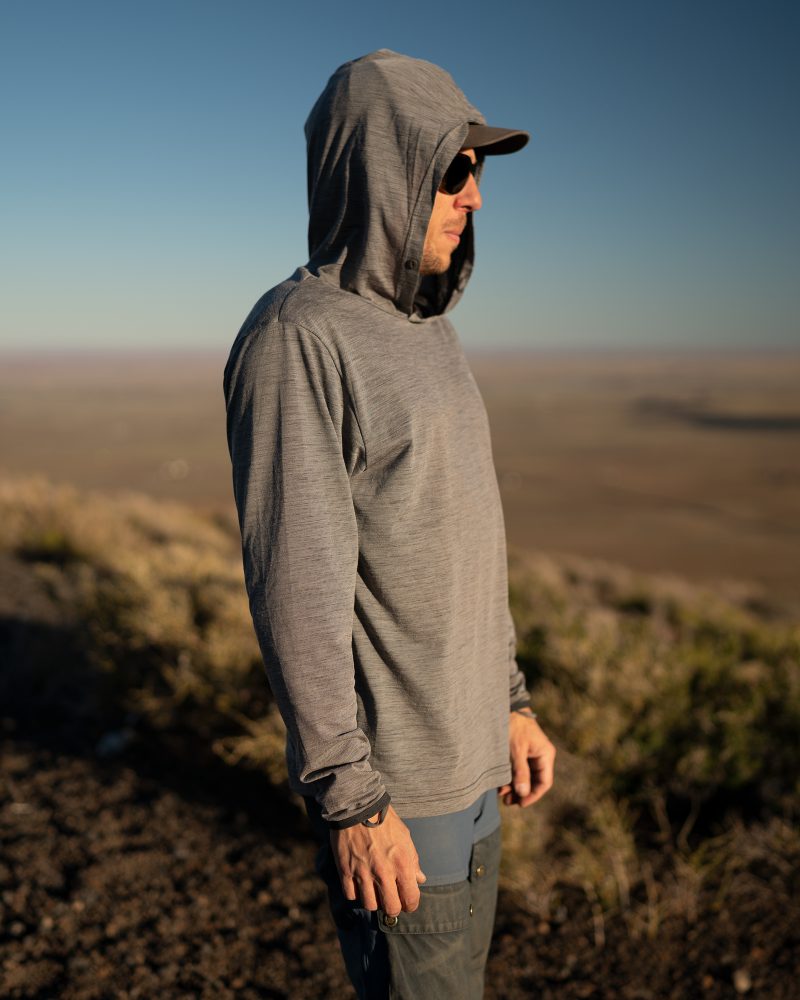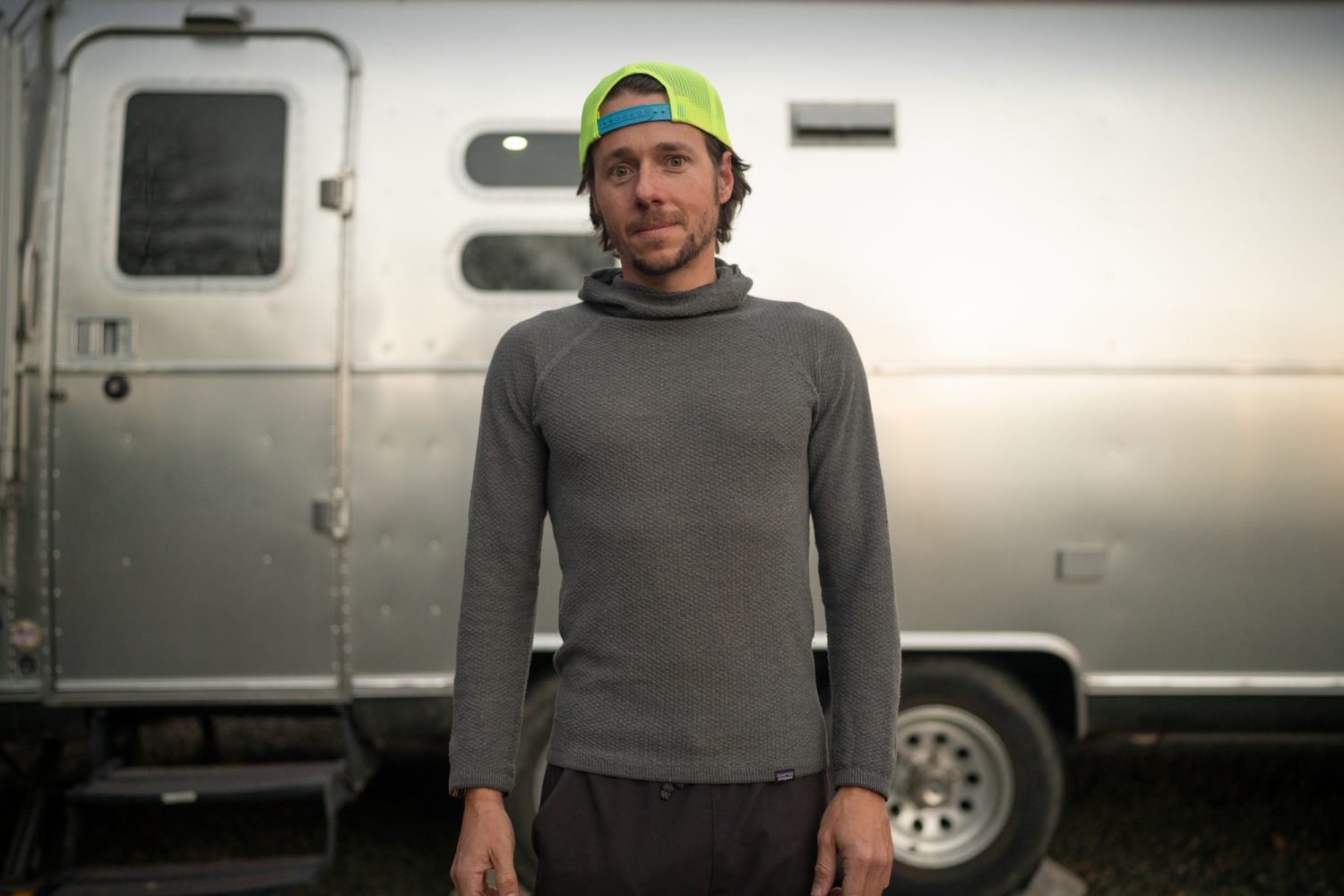Editor’s Note: This article was originally published in Overland Journal’s Spring 2022 Issue.
Photography by Richard Giordano and Amanda Winther
Base layers have come a long way since the waffle-patterned cotton tops and bottoms that we used to layer under our snowsuits as kids. Thanks to performance fabrics like merino wool and polyester, we now have a broader range of options.
Shopping for a good-quality base layer can be daunting, however. Many options abound, including synthetics versus wool, lightweight to heavyweight layers, and varying features such as hoods, zippers, and thumb loops. How do you compare Patagonia’s thermal weight Capilene with Icebreaker’s 250 long-sleeved crew?
Fortunately, for this Best of Breed, we have field-tested a variety of base layers from the leading brands. From warm to cold environments, plus a do-it-all layer that works at any time of year, here are our top picks.
Matt’s Take
Any time I’m dressing for activities in warm environments, be it as simple as a day of scrambling or as complex as a multi-day backpacking trip, my clothing system always includes a high-performance base layer.
Believe it or not, base layers are just as valuable in warm environments as they are in cold, and here’s why. Our bodies sweat to regulate core temperature through evaporative cooling. Base layers facilitate this process more efficiently by wicking moisture away from our skin and helping it evaporate quicker thanks to enhanced surface area (versus your bare skin).
But base layers have other benefits in warm climates. For instance, long sleeves, a hood, and a UPF rating mean that you don’t need to slather your entire body with sunscreen to be protected from ultraviolet radiation.
As mentioned above, base layers are made from various natural and synthetic materials like wool, polyester, and even bamboo. Regardless of which materials you prefer, all can be comfortable in warm climates. Through trial and error, I’ve learned that I favor wool blends, as long as they are not itchy. And no matter what kind of environment I’m bound for, I have come to appreciate the utility of a hood and zipper.
Ashley’s Take
The beauty of a well-chosen base layer is that it will serve you during multiple activities. As Matt mentions, high-performance base layers wick moisture away from the body, which can cool in warm temperatures. Interestingly, the wicking action of a base layer can also keep the body warm in cold temperatures by keeping skin dry. Add an insulating layer, like a fleece or down jacket, and an outer layer for wind and rain protection, and you’ll be comfortable in most environments.
Polyester is one of the most common fabrics used in the construction of synthetic base layers. It excels at wicking sweat, is very durable, and is okay in the odor-retention department. Wool wicks well, is more delicate, but is highly naturally resistant to odor-causing bacteria. Many find a blend between synthetic and wool hits the sweet spot.
My tried, tested, and true base layers have stayed close to my heart while hiking near Lake Louise, downhill skiing in Banff, ice skating on windy frozen lakes, backcountry camping in the autumn, dog sledding in the Northwest Territories, and during rock climbing sessions near Canmore, Alberta. Most base layer pieces look great, too—throw on a black merino top with a pair of jeans and some sneakers, and nobody will know your favorite tee was crammed into a duffle bag because you’ve arrived wrinkle-free.
Matt’s Picks
Beyond Clothing Celeris Midweight K2 Pullover (Cold Weather)

This midweight synthetic hoody is best suited for cold environments. However, despite its warmth, the Celeris is still versatile enough to be worn during the shoulder seasons as well as in summer months.
As an outdoor soft goods company, Seattle-based Beyond Clothing is still relatively new to me, although they have been designing clothing since 1996. After discovering them, their gear has quickly become some of my favorite outerwear for a handful of reasons. To begin with, Beyond is on a mission to reduce the environmental footprint of its business by utilizing compostable PrimaLoft BIO insulation, BlueSign-certified textiles, and OEKO-TEX-certified materials. They’re partnered with the Endangered Species Protection Agency, Seattle Stand Down Veterans’ support group, and Camber Outdoors.
Beyond’s clothing system is organized into a progressive range, from lightweight base layers (L1) to heavyweight winter parkas (L8), with the Celeris fitting into the lower end of that range (L2). In testing, I found it to be exceptionally warm nonetheless. It breathes well enough that I have worn it during aerobic activities in Southern California in November, although I was happy to utilize the chest zipper when I found myself getting overheated while hiking uphill.
The Celeris is constructed from Verso-Weave double-knit fleece (94 percent polyester, 6 percent spandex blend), with body-mapped lightweight side panels for better breathability. It features a hood, a deep 3/4-front zipper, thumb loops, and a small zippered pocket on the left sleeve that is big enough for a credit card or ID. The garment is finished with an antimicrobial treatment that enhances the moisture-wicking properties of the fleece.
Due to the pullover’s versatility, it can be worn next-to-skin, or if sized-up, as a mid-layer. Its stretchy construction allows for full range of motion, with sleeves that can be comfortably pulled up onto the forearms or elbows for extra temperature management.
I have noticed some slight pilling of the face fabric from normal use. While this doesn’t affect its performance, it may be visually unappealing to some. It is worth noting that this garment is too heavy to wear in many warm or tropical climates, so ultimately, you’ll need an additional, lighter base layer for those destinations.
Regardless of its limitations and taking into account the lifetime warranty on construction combined with its $80 price point, the Celeris is one of the best bargains in this collection of base layers.
$80 | beyondclothing.com
Voormi River Run Hoodie (Warm Weather)


As discussed earlier, base layers are just as valuable in warm climates as in the cold because of their ability to wick sweat away from your skin and facilitate faster evaporative cooling (thanks to enhanced surface area). In turn, this helps to more effectively regulate core temperature, keeping your body comfortable and functional. And whether they are UPF-rated or not, any fabric that covers the skin is a great chemical-free way of shielding yourself from ultraviolet radiation.
I’ve tried a wide selection of warm-weather base layers over the years, but my current go-to choice in desert and tropical climates is the River Run. I’ve especially appreciated this layer while hiking my paragliding gear up to launches in Southern California’s dry environment.
The River Run is a generously cut lightweight (7 ounces, men’s size large) hoodie constructed from dual-surface UL (ultralight) precision-blended wool. The texture of this material initially feels similar to linen, but with just a couple of washes, it softened up nicely. It has never felt itchy, even when wearing it for multiple days in a row. The River Run has surprised me with how well it manages odor; even after numerous days of physical activity back to back, it has fended off the dreaded base-layer stink.
Some of my favorite features include an oversized hood and thumb loops sewn into the cuffs. The benefit of the hood is multifaceted: it provides UV protection for the ears and neck when the sun is overhead and delivers a little bit of extra warmth when the sun has gone down. The thumb loops aid in keeping the sleeves from bunching up when pulling on an extra layer.
The River Run boasts many qualities that make it one of my top-choice base layers for warm environments, but that doesn’t mean there isn’t room for improvement. I have found myself wishing that the cuffs and sleeves were stretchier so that I could roll them up when I am hot. I would also love to see a future version of this layer offered with a 1/4-zip or buttoned top to more easily facilitate ventilation during high-output activities.
Like other wool base layers, you’ll want to make sure that you wash the River Run with a wool-specific or powdered, unscented laundry detergent and air-dry it for best performance.
$129 | voormi.com
Patagonia Capilene Air Hoody (Do-it-all)


I previously worked for Patagonia at three different retail locations. Over the course of my time with the company, I had the opportunity to try just about every base layer they offered. This includes their original polyester Capilene long underwear to more contemporary items such as the Capilene Cool Daily T and R1 lightweight fleece (not technically a base layer, but it works in cold climates).
And because I’ve tried so many different options, it allows me to say with even more confidence that the Air Hoody is my favorite base layer the company has ever designed. I’ll take that statement a step further and say that the Cap Air is one of the best base layers I’ve ever owned, period.
What makes it such a top-notch item? First of all, it is lightweight (the lightest in their base layer lineup), enough to be used year-round in many parts of the world (well, maybe not in the Amazon), while still delivering sufficient thermal performance for cold-weather activities like skiing or snowshoeing. I have worn it on sub-zero mid-winter skiing days in Colorado and when scaling sandstone cracks in the deserts of Utah. I attribute the year-round comfort of the Cap Air to two factors: the open, breathable, and stretchy weave of the fabric; and its merino and polyester fabric blend.
The weave is reminiscent of the old-school waffle-patterned long underwear but with notable improvements. It is stretchy, hugging the body closely while still allowing unrestricted movement and providing superior breathability. If I get overheated while hiking (or skiing) uphill, all I need to do is remove my outer layer, exposing the Cap Air to a gentle breeze, and within minutes, I’ve dried out and cooled off.
The merino and polyester fabric blend provides a first-rate warmth-to-weight ratio, striking a balance of moisture-wicking, quick-drying, and odor management—thanks to wool’s naturally antimicrobial properties). It’s one of the few next-to-skin wool layers that has never felt itchy to me.
But as with every piece of gear out there, the Cap Air’s advantages come with a couple of tradeoffs you should be aware of. Because of the wool content of this garment, it is more delicate than your average base layer. I’ve definitely had to sew a few holes in mine over the years. And again, due to the wool content, you’ll only want to wash the Cap Air with a gentle detergent (powdered, unscented is best) and air dry to avoid shrinking.
$149 | patagonia.com
Honorable Mentions
Patagonia Capilene Thermal Weight Zip-Neck This is an excellent and versatile synthetic base layer offering a little bit more warmth than the Capilene Air. The Capilene Thermal weight zip-neck top is one of my other all-time favorites and comes in a hooded version.
$99 | patagonia.com
Airblaster Ninja Suit For those of you that need a cold-weather base layer for activities like snowshoeing or skiing, the Ninja Suit is a one-piece synthetic or merino outfit with a full seat zipper, a hood, and thumb loops.
$110 | myairblaster.com
Fjällraven Bergtagen Thinwool Longsleeve Fjällraven’s Bergtagen base layer is one of the softest, stretchiest tops that I’ve tried on. As the name implies, it is on the lighter side, making it a versatile option in warm and cold climates.
$100 | fjallraven.com
Ashley’s Picks
Icebreaker Merino 260 Tech Long Sleeve Crewe Thermal Top (Cold Weather)


Dissatisfied with the synthetic outdoor apparel of the mid-nineties, Icebreaker founder Jeremy Moon paid an unexpected visit to a sheep ranch on New Zealand’s Pohuenui Island, where a farmer had been experimenting with merino wool. Moon fell in love with the soft, lightweight, high-performance fabric, which he felt was the perfect alternative to plastic-derived polyester. Icebreaker clothing is now available in over 40 countries, and the company is committed to a strict animal welfare code, environmental sustainability, and fostering long-term relationships that span the globe.
Icebreaker’s 100 percent merino Crewe is designed for winter temperatures, promising warmth, odor resistance, and temperature regulation. Uncomfortable fabrics are a deal-breaker for me, and I have found some merino wool base layers to be itchy and irritating to my sensitive skin—but not this one. It is soft, fits nicely, and is incredibly comfortable. I donned this top nearly every day, all day, and often all night during a winter trip to the Canadian Arctic. It was washed infrequently on that trip but remained odor-free nonetheless. Despite the thickness of the wool, I never felt stifled or clammy.
The 260 Tech is also my go-to for any outdoor activity in cooler and cold temperatures, whether it be hiking, trail running, skiing, or ice skating during the depths of winter. The lack of zipper or hood are pros in my book—I like to add a buff from time to time and don’t want to wrangle multiple head coverings and zippers from jackets and sweaters when layered up.
The nature of travel prevents us from toting along an extensive wardrobe, so I am a huge fan of multi-purpose pieces. This top looks sharp as a high-performance piece or a casual shirt worn for sightseeing, grocery shopping, or grabbing a coffee with friends. Wear it underneath a little puffy vest, and you’ll look cute as heck. The cut and fit are stellar, and the neckline is flattering, which is a relief from some of the strange scoop and wide cuts out there. By incorporating an offset shoulder, flatlock, and backward set side seams, Icebreaker has focused on preventing friction.
Some might argue the shirt’s thickness and fabric content don’t dry as quickly as a lightweight base layer would. Another potential snag could be for those that naturally run hot or warm. I tend to run on the cold side and spend quite a bit of time in sub-zero temperatures. For those conditions, this top is perfect.
To properly care for this garment, Icebreaker recommends machine washing warm with like colors (without softeners or bleach) before hanging to dry in the shade (do not tumble dry).
$115 | icebreaker.com
Duckworth Women’s Vapor Tee (Warm Weather)


Founded on a Montana ski hill, Duckworth prides itself on making versatile merino wool that is 100 percent Montana-grown and 100 percent American-made. It all begins at a ranch in Dillon, Montana, operated by Duckworth co-founders and fourth-generation sheep ranchers, the Helle Family. Their flock of sheep lives at between 5,000 and 9,500 feet of elevation in the Northern Rockies, which, according to Duckworth, results in an “incredibly soft, yet durable fiber with exceptional loft and breathability thanks to an unparalleled degree of ‘crimp’ within the fleece.” Fleece is graded for quality before it is spun, knit, and dyed. Fabrics move to the Eastern Seaboard and Midwest, where they are finished into garments.
The Vapor tee is a lightweight T-shirt designed to be cooling, antimicrobial, moisture-wicking, and ultra-fast drying. At 150 gsm, it is made to be worn hard and sweated in. Fabric composition includes 38 percent Montana merino wool, 50 percent recycled polyester, and 12 percent modal (bamboo pulp). Available in multiple colors, I would buy every single one of them.
I’ve been on the hunt for a solid line of travel T-shirts for some time now. It has been challenging to track down a plain tee with no graphics that fits well, goes with everything, feels soft, serves more than one function, and doesn’t rise from my packing cube wrinkled to the point of public embarrassment. Overlanding can be incredibly wearing on clothing, so I needed something that would last. When this tee showed up, I was impressed and didn’t hesitate to put it to the test.
First off, the material feels nice and isn’t scratchy or itchy. The neckline is slightly wider than I prefer, and the length might be a bit long for those with short torsos, but that’s just being nitpicky. Implementing a French tuck could solve that problem easily. The fit was slightly large, and I would probably go down a size in the future, but overall the lines and color options are flattering.
I subjected the Vapor to several beatings, including donning it for workouts via my exercise app (it accompanied me during a particularly rigorous set of burpees), hiking, and rock climbing. I wore it underneath a sweater while I pulled a near all-nighter during the Baja 1000 race, slept in it, and wore it as a general travel T-shirt with jeans. I crumpled it up in a ball and threw it in my duffel bag, hand-washed it twice, and subjected it to a sweaty day in our non-air conditioned Toyota Pickup in southern Arizona. All in all, it performed well, and I will gladly add a few more to my wardrobe.
Duckworth’s care instructions suggest gentle machine washing with like colors (or hand-wash as I did). Dry flat or line dry only. It can be reshaped while wet.
$65 | duckworthco.com
Smartwool Women’s Merino 250 Base Layer 1/4 Zip (Do-It-All)


Founded in 1994 by ski instructors Patty and Peter Duke, Smartwool became the first outdoor company to specialize in performance merino wool ski socks. Since then, the company has expanded significantly, offering a wide range of apparel and accessories with one common denominator: merino wool.
Smartwool uses 100 percent responsibly sourced merino (ZQ Merino), a wool certification standard run by the New Zealand Merino Company. This certification mandates that growers meet strict animal welfare standards, environmental sustainability, fiber quality, traceability, and social responsibility. Initiatives are many, including a sock recycling program and the use of plant-based dyes such as madder root, lac, and Punica granatum.
This 100 percent merino base layer is no stranger to positive accolades, with numerous glowing reviews spanning the web. The midweight top comes in 14 different colors, offers UPF20+ protection, and is equipped with an 8-inch (20-centimeter) center front zip with a semi-locking slider. Well-constructed shoulder panels and flatlock seam construction work as advertised, minimizing chafing.
The fabric is glorious—so warm, so soft—while offering stellar breathability. Depending upon your preference, the top works well as a next-to-skin piece while leaving room for a tank underneath if you so choose. It is light enough, with slim enough construction, to be worn on its own during shoulder season underneath a fleece or puffy jacket. The 1/4 zip isn’t too tight, doesn’t chafe, and provides lovely ventilation when unzipped.
From Tuktoyaktuk to the Baja peninsula, this base layer has proved to be robust, odor-free, and versatile for me. The material provides good stretch, and the arm length is long enough to tuck your hands inside the sleeves if you are without gloves. Again, the flattering fit makes it easy to wear on the ski hill, on an airplane, or with jeans and sneakers as casual streetwear.
Smartwool’s 1/4-zip base layer is rated at 250, which is on the thicker side. For those living in hot, humid climates, this top might be too warm, and during scorching summer days, a lighter base layer would be a better fit. But, as I sit here typing on a cool Baja morning in November, I don’t regret packing this top one bit.
For optimum care, Smartwool suggests machine washing on a warm, gentle cycle. Tumble dry on low.
$105 | smartwool.com
Honorable Mentions
Voormi Women’s Short Sleeve Merino Tech Tee: The lightest of the layers I tested, this Voormi tee weighs just under 100 grams per square meter and is made from a blend of wool and cotton. Initially, I found this top a bit scratchy, but it softened with time and is now one of my go-to tops for athletic pursuits in warm environments.
$70 | voormi.com
Duckworth Comet Tunnel Hood: At 275 gsm, this is an excellent option for those frigid winter days when you’re looking for a high-performance piece that is also cozy and looks great. Duckworth’s Comet fabric combines a 100 percent Montana-grown merino wool outer layer with a polyester inner layer. The high neck and hood aren’t too tight, and the top comes in multiple colors. Duckworth customers have worn the Comet Tunnel Hood on expeditions in Antarctica and Alaska.
$150 | duckworthco.com
Our No Compromise Clause: We carefully screen all contributors to ensure they are independent and impartial. We never have and never will accept advertorial, and we do not allow advertising to influence our product or destination reviews.


